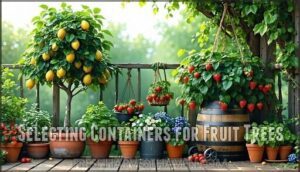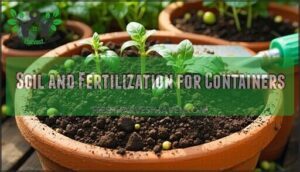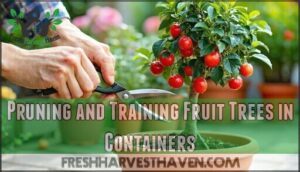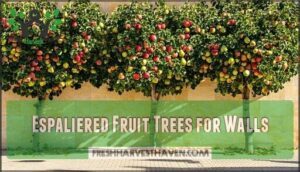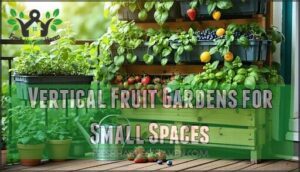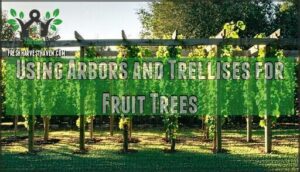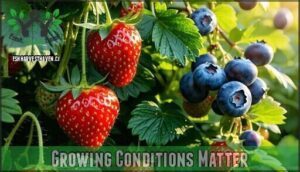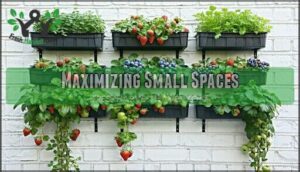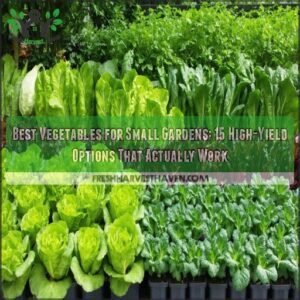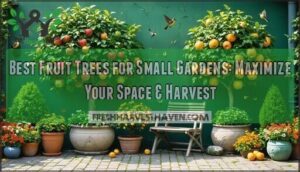This site is supported by our readers. We may earn a commission, at no cost to you, if you purchase through links.
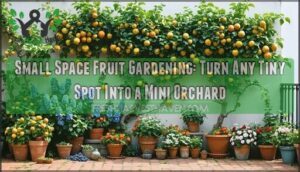 You can absolutely master small space fruit gardening with the right approach.
You can absolutely master small space fruit gardening with the right approach.
Start with dwarf fruit trees in containers—they’re your best friends for balconies and patios.
Apple, peach, and citrus varieties thrive in 15-20 gallon pots.
Berry bushes like blueberries and strawberries work perfectly in smaller containers.
Don’t overlook vertical options either.
Train fruit trees against walls using espalier techniques to save space while creating living art.
Choose self-pollinating varieties to maximize your harvest without needing multiple trees.
With proper container selection, quality potting mix, and regular watering, you’ll transform any tight spot into a productive mini orchard that delivers fresh fruit season after season.
Table Of Contents
- Key Takeaways
- Choosing Fruit Trees
- Container Gardening
- Vertical Gardening Options
- Growing Conditions Matter
- Maximizing Small Spaces
- Frequently Asked Questions (FAQs)
- What fruit trees grow in small spaces?
- What fruit plants are good for small gardens?
- Where to plant fruit trees in a small yard?
- What fruits cannot be planted together?
- How to grow fruit in a small fruit garden?
- Can you grow fruit in a container garden?
- Can you grow fruit in a small apartment?
- How do you grow dwarf fruit trees in a container?
- Can you grow fruit on a balcony?
- Can You Grow your own mini fruit garden?
- Conclusion
Key Takeaways
- Choose dwarf fruit trees and compact berry varieties in 15-20 gallon containers—they’ll produce full-sized harvests while fitting perfectly on your balcony or patio.
- Maximize your growing space by training trees vertically using espalier techniques against walls and installing tiered container systems to triple your fruit production area.
- Select self-pollinating varieties so you won’t need multiple trees for fruit production, and focus on species like Meyer lemons, compact blueberries, and columnar apples that thrive in containers.
- Provide well-draining soil with proper pH (6.0-7.0), consistent watering when soil feels dry one inch down, and 6-8 hours of daily sunlight for healthy fruit development in your small space garden.
Choosing Fruit Trees
You don’t need a sprawling backyard to grow fresh fruit when you choose the right trees for your space.
Dwarf varieties and compact berry bushes can produce full-sized harvests in containers, while columnar trees and espaliered options maximize vertical growing areas.
Dwarf Fruit Trees for Containers
When you’re dreaming of fresh fruit but working with limited space, dwarf fruit trees become your best allies.
When space is tight, dwarf fruit trees prove that big harvests come in small packages.
These compact powerhouses reach just 8-10 feet tall, making them perfect for container fruit gardens on patios or balconies.
Choose proper container size and rootstock selection for success.
Many dwarf fruit varieties thrive indoors during winter, requiring only occasional moving trees for maximum sunlight exposure.
Selecting self-fertile varieties guarantees fruit production even with a single tree.
Compact Fruit Varieties for Small Spaces
Beyond dwarf trees, you’ll discover compact fruit varieties that pack full-sized flavor into smaller packages.
Genetic dwarfing creates naturally miniature plants perfect for patio fruits and container fruit gardens.
Your space optimization strategy should include:
- Dwarf citrus trees like Meyer lemons and kumquats
- Columnar apples that grow tall but stay narrow
- Multi-grafted trees producing several fruits on one trunk
- Compact stone fruits designed for small space fruit gardening
Berry Varieties for Small Spaces
Berries pack serious punch in tiny spaces.
Strawberries thrive in hanging baskets while blueberries like Tophat stay compact in containers.
Raspberry Training becomes simple with dwarf varieties like Raspberry Shortcake. For Blackberry Care, choose thornless Baby Cakes that won’t sprawl.
Gooseberry Cultivation works great in sunny spots, and Honeyberry Benefits include cold tolerance.
These berry plants deliver fresh fruit without hogging space in your small space fruit garden.
Container Gardening
You don’t need a backyard to grow fresh fruit when containers can transform any patio, balcony, or sunny corner into a productive mini orchard.
Container gardening gives you complete control over soil quality, drainage, and placement while keeping your fruit trees portable and manageable, allowing for a productive mini orchard.
Selecting Containers for Fruit Trees
Your container’s success depends on smart choices that balance function with form.
Choose containers 18-20 inches wide for most fruit trees in pots, ensuring proper drainage solutions with multiple holes.
Terra cotta offers aesthetic appeal but weighs more than plastic options.
Consider portability options like wheeled bases for larger garden containers.
Many gardeners find success with specialized tree containers.
Material choices affect durability—whiskey barrels excel for dwarf fruit trees in container gardening.
Soil and Fertilization for Containers
Your containers need well-drained soil with proper pH balance for healthy fruit production.
Mix quality potting soil with compost to meet nutrient needs of your plants. Container drainage prevents root rot while organic fertilizers feed plants gradually.
Test soil health regularly and add soil amendments as needed. Consider specialized fruit blends for ideal growth.
Good soil requirements set the foundation for successful fruit plant fertilization in container gardening, ensuring healthy fruit production.
Pruning and Training Fruit Trees in Containers
Pruning techniques shape your container dwarf fruit trees for maximum production. Start dormant pruning in late winter to control size and encourage fruit load.
Remove dead branches and thin overcrowded areas.
Container shaping keeps trees compact while maintaining their natural form.
Don’t forget root pruning every few years – trim circling roots when repotting to prevent binding and promote healthy growth.
Vertical Gardening Options
You can triple your fruit-growing space by using walls, trellises, and vertical structures to train trees and vines upward instead of outward.
These methods turn blank walls into productive growing areas while keeping your ground space free for other plants or activities, which allows for more efficient use of space.
Espaliered Fruit Trees for Walls
When you master espalier techniques, you’ll transform any blank wall into a productive small space orchard.
These espaliered fruit trees grow flat against surfaces, maximizing your vertical fruit garden potential.
Plant trees 8-12 inches from walls, then train branches horizontally using proper pruning methods. This approach delivers impressive fruit yield while creating stunning living art for apartments.
Vertical Fruit Gardens for Small Spaces
You can transform cramped balconies into productive vertical fruit gardens using DIY structures like stacked planters and tower systems.
Smart fruit selection matters—choose compact berries and dwarf varieties for apartment living. Space maximization techniques include tiered containers and wall-mounted systems.
Regular maintenance tips include proper watering schedules and seasonal pest control. Limited space fruit gardening becomes manageable with strategic vertical gardening approaches.
Consider exploring available product options for your setup, utilizing DIY structures and applying space maximization techniques for a successful vertical fruit garden.
Using Arbors and Trellises for Fruit Trees
Build sturdy arbors and trellises to support climbing fruit plants like grapes and kiwi vines.
Your trellis design should handle fruit weight while encouraging vertical growth. Space optimization becomes simple when you train vines upward instead of outward.
Trellised grapevines produce abundant harvests in minimal ground space. Choose materials that withstand weather and support heavy fruit loads effectively.
Vertical gardening also improves airflow and plant health and is a key factor in abundant harvests, minimal ground space, and overall plant health.
Growing Conditions Matter
You can’t just plant fruit trees anywhere and expect them to thrive. Your plants need specific light, water, and soil conditions to produce healthy fruit in small spaces.
Light Requirements for Fruit Trees
Most fruit trees crave full sun—six to eight hours daily for ideal sunlight exposure.
However, some varieties like gooseberries and honeyberries tolerate partial sun conditions beautifully.
Check your garden sunlight patterns throughout the day to match sunlight requirements with plant needs.
Consider artificial lighting for indoor containers during winter months, ensuring proper light spectrum for healthy growth and fruit production.
Watering and Fertilization Needs
Your fruit trees need consistent care to thrive in containers. Proper watering frequency and fertilizer types make the difference between struggling plants and abundant harvests.
Here’s your essential fruit care checklist:
- Water when soil feels dry one inch down
- Use balanced fertilizer monthly during growing season
- Watch for yellowing leaves indicating nutrient deficiencies
- Check soil pH stays between 6.0-7.0
- Verify drainage solutions prevent waterlogged roots
To maximize growth, consider that morning watering benefits fruit trees by promoting better absorption.
Soil Preparation for Fruit Trees
Your fruit tree containers on balcony need well-drained soil with proper pH levels between 6.0-7.0.
Garden soil alone won’t work – mix in organic matter like compost to boost soil health.
Test drainage importance by checking if water flows freely through holes. Add soil amendments like perlite for better structure.
Nutrient needs vary, but quality potting mix provides essential nutrients for thriving fruit trees.
Maximizing Small Spaces
You can triple your growing space by training fruit trees to grow vertically and using wall-mounted containers.
Smart techniques like espalier training and stacked planters turn walls and fences into productive growing areas, utilizing vertical space efficiently.
Training Fruit Trees for Space
Since space is precious, espalier techniques transform ordinary fruit trees into living art against walls and fences.
Cordon training keeps trees compact by radiating branches from a short trunk, and fan-shaped pruning methods maximize light exposure.
These fruit tree training approaches, including the use of vertical structures to support growth, let you grow multiple compact fruit trees in surprisingly small areas.
Using Wall Mounted Containers
Wall-mounted containers transform bare walls into productive growing spaces.
Choose sturdy container materials like reinforced plastic or metal with proper drainage solutions. Select compact fruit varieties that thrive in vertical gardening setups.
Position containers at eye level for easy maintenance tips and aesthetic appeal. This space-saving gardening approach maximizes small garden fruit production while keeping your fruit in pots accessible, using vertical gardening setups with proper drainage and compact fruit varieties.
Creating a Vertical Fruit Garden
Transform your balcony fruit plants into a towering garden with DIY structures that climb skyward.
Stack strawberry towers, train compact fruit bushes on trellises, and hang fruit in pots at different levels.
This vertical gardening approach triples your harvest while optimizing every inch.
Consider also how soil pH is critical for ideal fruit tree health. Choose climbing varieties, follow maintenance tips for watering each tier, and enjoy your space-saving small garden fruit paradise.
Frequently Asked Questions (FAQs)
What fruit trees grow in small spaces?
Like Jack’s beanstalk reaching skyward, you’ll find dwarf varieties thrive in containers.
Choose columnar apples, dwarf peaches, compact citrus trees, or espaliered options.
They’ll produce full-sized fruit while fitting perfectly on patios, balconies, or tiny yards.
What fruit plants are good for small gardens?
You’ll love dwarf blueberries, compact strawberries, and thornless raspberries for small gardens.
Try vertical-growing passion fruit vines, container-friendly citrus trees, and space-saving gooseberries.
These productive plants maximize your harvest without overwhelming your garden space.
Where to plant fruit trees in a small yard?
You’ll find success placing dwarf fruit trees near sunny walls for warmth and protection.
Choose spots with morning sun, good drainage, and easy access for care.
Consider container placement on patios for flexibility.
What fruits cannot be planted together?
You shouldn’t plant black walnut trees near most fruits since they release juglone, which kills apples, cherries, and berries.
Keep stone fruits away from apples to prevent cross-pollination issues affecting fruit quality.
How to grow fruit in a small fruit garden?
Who knew tight spaces could yield big harvests?
You’ll maximize your small fruit garden by choosing dwarf varieties, using vertical trellises, growing in containers, and selecting compact berries like strawberries and blueberries for maximum production.
This approach allows for maximum production in a small area, making the most of the space available.
Can you grow fruit in a container garden?
You can absolutely grow fruit in containers.
Choose dwarf varieties like compact blueberries, strawberries, or dwarf citrus trees.
Use large pots with drainage holes and quality potting soil for best results.
Can you grow fruit in a small apartment?
Despite limited space, you can absolutely grow fruit in small apartments.
Choose compact varieties like dwarf citrus trees, strawberries in hanging baskets, or vertical berry gardens.
Sunny windowsills and balconies work perfectly for container fruit growing, using compact varieties.
How do you grow dwarf fruit trees in a container?
Choose containers at least 20 gallons with drainage holes.
Use quality potting soil, not garden dirt.
Place in full sun and water regularly.
Prune annually to maintain size and shape for healthy fruit production.
Can you grow fruit on a balcony?
You can definitely grow fruit on a balcony.
Strawberries, dwarf citrus trees, and compact blueberry bushes thrive in containers.
Choose sunny spots, use proper drainage, and you’ll enjoy fresh fruit in your small space.
Can You Grow your own mini fruit garden?
You can create your own mini fruit garden using containers, vertical structures, and dwarf varieties.
Strawberries, dwarf citrus trees, and compact berry bushes thrive in small spaces, providing fresh fruit year-round.
Conclusion
Transform your cramped quarters into a fruitful paradise with these small space fruit gardening strategies.
You’ve learned to maximize vertical walls, choose compact varieties, and master container growing techniques.
Your balcony or patio can now produce fresh apples, berries, and citrus year-round, with proper container sizing, consistent watering, and strategic pruning making all the difference.
Start small with one dwarf tree, then expand your mini orchard as your confidence grows, and remember that fresh homegrown fruit awaits you.
- https://www.gardentech.com/blog/how-to-guides/how-to-grow-and-care-for-a-dwarf-peach-tree
- https://www.tenthacrefarm.com/how-to-build-a-fruit-tree-guild/
- https://www.chrisbowers.co.uk/article/the-essential-guide-to-columnar-fruit-trees/
- https://www.gardenersworld.com/plants/10-best-fruit-crops-for-shade/
- https://urbangardengal.com/small-watermelon-varieties

